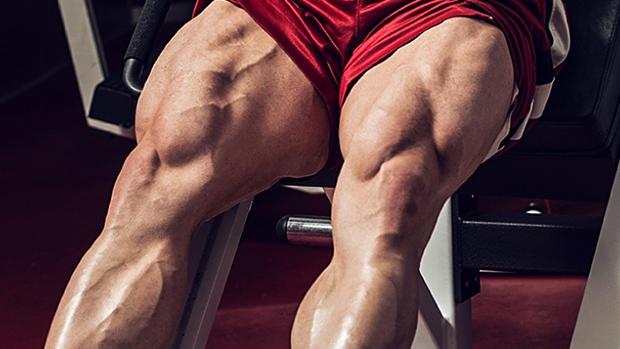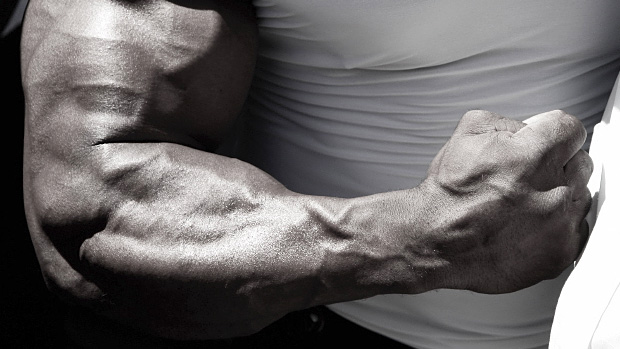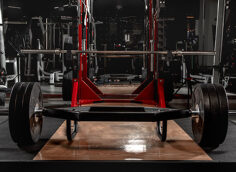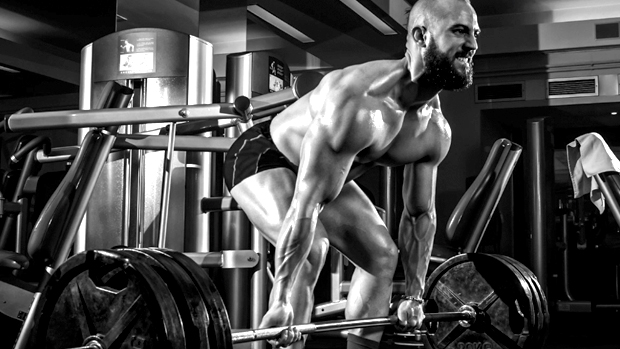"The Ultimate Bulk and Power Theory" was a series of articles written in the old Iron Man Magazine in 1976 by Dennis Dubreuil, and later revisited by bodybuilding scribe Greg Zulak in 2003.
Dubreuil theorized that while strength and size were related, training specifically for muscle size had some unique rules. Dubreuil based his conclusions largely upon his own research and personal experimentation (not too much dipping into PubMed back then) but his findings are still worth exploring for the size-focused trainee.
Here's a stripped-down list with some bullet points after each rule.
The Dubreuil Effect
1 – Work only a small area of the body at one time.
- Focus on maximum pump and blood flow.
- Focus on keeping fatigue products in the muscle.
- Fatigue products must be left in the muscle for at least 20 minutes.
- Work about two related muscle groups per session.
A Crossfit-inspired workout of deadlifts alternated with running up a mountain in colorful knee socks might appeal to some, but it won't work as we're training for hypertrophy, not metabolic circuits. Conditioning-focused workouts don't localize blood flow or fatigue products.
2 – Work as hard as possible every repetition.
- You can use rest/pause sets.
- You can use descending sets.
- You can use descending ladders.
- You can use a training partner for forced reps.
- You can use TAT [tension alteration technique] or LAT [leverage alteration technique].
The goal is hypertrophy, not improving your powerlifting numbers or developing the "skill of strength." You want to take that muscle and work it as hard as possible for every repetition. That means having the flexibility to reduce the load slightly as you fatigue.
Since you're using a high amount of isolation exercises, the systemic shock will be less, although the localized pain and discomfort will be unbearable. Training this way is not meant to be a walk in the park.
3 – Focus on isolation exercises.
- Heavy compound exercise builds overall size and strength and should be used by new trainees or immature trainees.
- This protocol is about maximizing development of individual muscle groups not about your squatting technique with chains.
- Isolation exercise focuses on fewer variables. Anything we focus on gets bigger. Remember, when you chase two rabbits, you miss both of them.
- Use of single-limbed exercise is a powerful tool in this method.
4 – Use a variety of exercises.
- Rotating exercises will ensure balanced development.
- You avoid injury with variety but still improve by applying "the same but different" method.
- Psychologically, it may be difficult facing up the same drills week after week if they produce as much discomfort as the Dubreuil Effect.
5 – Limit rest.
- When working isolated muscle groups, severely limit rest. Endeavor to work more within less time by using less rest between sets but not altering rep speed.
- You will get ample rest between body parts, so lying down and crying from pain is okay.
6 – Specific recovery from the previous day's training is of utmost importance.
- Light activity on the day after training may enhance recovery.
- The reduction of soreness enhances well being and makes training more pleasurable.
- High repetitions are needed. These can be pumping motions or a light aerobic session.
7 – Maintain your fitness.
- Your ability to recover from training can depend on your overall fitness level.
- Minimal cardiovascular training will not affect your muscle building effort. However exhaustive conditioning drills will.
- Cardio can be used as a recovery tool for specific muscle groups.
In the original material Dubreuil mentioned using double and even triple-split training. However, most normal humans have lives, jobs, and responsibility. With a few common sense tweaks the Dubreuil Effect can make for a viable training cycle:
- Do this for three weeks on, one week off, and then repeat. Move to another program after that.
- Have a committed training partner who will push you. He/she can arrange gear and help with descending sets, coaching form, and motivation.
- Use a stopwatch to limit rest.
- For cardio training, a stationary bike and rowing machine are necessary. Battling ropes would be nice, too, or you can substitute a heavy bag.
- A training journal is necessary to keep accurate records.
- Workout "chunks" should be arranged this way:
- Do your recovery cardio first as a warm-up.
- Push through your first body part segment.
- Push your partner through his first segment as you recover.
- Push through your second body part segment as your partner recovers.
- Push your partner through his second segment as you recover.
In other words, warm-up for 12 to 15 minutes, then 20 minutes on, 20 minutes off, 20 minutes on.
Here's your schedule.
- Day 1: Quads/Hip Flexors, Hamstrings/Calves. No cardio.
- Day 2: Stationary bike, Back/Traps, Biceps/Forearms.
- Day 3: Rowing machine, Chest/Shoulders, Triceps.
- Day 4: Heavy bag or Battling Ropes, Abdominals, Neck.
- Day 5: Rest.
- Day 6: Cycle repeats.
Day One
Quadriceps
Your primary drill will be the single-leg press. You may use descending sets or descending ladders. The only rest allowed is when one leg is working and the other is recovering.
The weight should only allow five repetitions in good form for rest/pause. For descending ladders, start with 10 reps left leg, 10 reps right, then 9/9, 8/8, and so on until you get to one rep. Rest for one minute, reduce the weight, and repeat.
With no rest, run (ha!) to the leg raise station.
Hip Flexors
You need to expose the upper thigh to hard exercise to get results. Start with straight or slightly bent leg hip flexion. You can do these on those padded-elbow support stations used for doing leg raises. You simply support your body weight with your elbows and do what your high school gym teacher used to call leg raises. Continue until you can't lift your thighs. Take 30 seconds rest and repeat with your legs bent 90 degrees at the knee.
Continue until you can't move, then step off the machine and do in-place alternate high knee marching. Hold the top position with the thigh level to the ground for a two-count. Hold onto something for balance and continue until you can't stand.
Rest while you assist your training partner with his sets.
Hamstrings
Have your training partner stand near the weight stack of the leg curl machine. You'll be doing descending sets. Use a weight that will allow 3-4 repetitions, moving in a slow cadence. As you grind to a halt, lower the weight and have your training partner lower the pin on the weight stack by one plate. Repeat this process until you run out of weight on the machine.
Take a 30-second break and start again with 20% less weight than the first series. Focus on slow movement and isolating the hamstrings. After finishing your last rep, spend a minute or two stretching your hamstrings.
Calves
Use the standing calf machine for "Two up/One down" calf raises. Use two legs to raise the weight stack but only one to lower it. Take five-seconds to raise, five-seconds holding in peak contraction, and five seconds to lower. This will increase the time under tension and ensure the repetitions are difficult enough. Keep the knees locked and have your training partner cue you appropriately on time and form.
Be sure to start at a weight that you can do for eight total repetitions; that's eight concentric reps and four reps eccentric for each leg. As your form deteriorates, have your partner remove some poundage and continue. You literally want to work as hard as possible until movement isn't possible with the lightest poundage.
Day Two
Exercises
Begin with 12-15 minutes on the exercise bike to warm-up and relieve soreness from the lower body. This should feel good and actually pump the muscles.
Back/Lats
Most chest-supported rows are available in "high, medium, and low" handle configurations. To ensure overall stimulation, rotate these every workout, performing them rest/pause style. With rest/pause, choose a heavier than standard weight, do as many reps as possible, pause, then repeat until a proper rowing motion using good form is impossible. At that point move on to lat shrugs.
Lat shrugs are simply pinching the shoulders back without arm flexion while keeping the shoulder packed down and lats flexed. Do as many as possible after the chest-supported rows, again in rest/pause style. That would be considered one cycle. Now reduce the original poundage that was used in the supported row and repeat the above sequence.
The second part of the back workout is alternating seated shrugs with dumbbells and hyperextensions with weights. Choose dumbbells that allow about 20 repetitions, but only do 10. The same with the hyperextensions. Start with added weight if needed but do only 10 smooth reps. Alternate between the two exercises in a descending ladder: 10 shrugs, 10 hypers, 9 shrugs, 9 hypers, until down to 1/1. No rest.
Take a break and force your training partner through his back workout.
Biceps/Forearms
Less weight is required to train the arm flexors since the heavy rowing will have taken its toll. The emphasis then is not to maximize weight, but to make sure every repetition is miserable. To that end, line up three fixed-weight barbells or have one barbell that can be stripped of weight quickly. The back of your head, upper back, butt and heels must be pressed against an upright post or pole. They can't move and it's the job of your training partner to enforce this through verbal cues.
Begin with the reverse curl and do three drop sets. Move in a slow, controlled, fashion – this isn't a clean and jerk. When movement is impossible, either strip the bar or use a lighter one and continue. Little to no rest is allowed. Stop when movement ceases and repeat for your third and final drop set.
It's time to take off one minute and rest your arms. However, don't get rid of the barbell. You'll be repeating the process with standard curls while bracing against a post. Same rules apply – move slowly until form fails and repeat three times.
On the very last set bend your knees, fold forward at the hips, and rest your forearms along your thighs. You'll be finishing up with wrist curls on a 45-degree angle. Move smoothly as you curl and uncurl your wrist. Do not let the bar unroll to your fingers – simply knock out as many wrist curls as possible keeping the lower arms glued to your thighs.
Due to the fatigue products and workout load, this will be extremely painful so focus on your breathing to distract yourself. When you can no longer curl your wrists, let the bar roll to your finger tips and clench and uncurl the fingers till safety becomes an issue and the reality of dropping the bar looms.
That's it for your training. Take a break and train your partner.
Day Three
Exercises
Begin with 12-15 minutes on the rowing machine to remove the waste products from yesterday's workout. This will also improve your fitness and aid recovery.
Shoulders/Chest
This will be a highly unusual series. You'll need an adjustable incline bench that has four settings from near vertical to flat. You'll also need a variety of dumbbells at your disposal.
Set the bench at a few degrees short of vertical. Begin with the palms-up iron cross. From a seated position, press the dumbbells overhead so that all four bells touch. With a slight bend in the arms, slowly lower the arms to parallel, in a crucifix position, holding the palms up. Don't go any further as it won't do much to increase the value of the exercise and puts you in a position of extreme leverage disadvantage. Pause for one count and return to the overhead position.
As your form erodes, shift to the starting position of the dumbbell press. You'll now continue with as many presses as possible until you can't lift the 'bells in good form.
Next, adjust the bench to a high incline and repeat with what will be a very high incline fly, immediately followed by a press. Continue the process until you're down to a flat bench. You may rest slightly between sets since they're brutal!
Using this method won't require very heavy dumbbells, but keep several sizes available since individual limb length, muscle attachments, and strength can vary greatly between trainees. Some individuals will require a weight adjustment between the fly motion and the press as well. Choose a weight that will allow 4-6 flyes or iron crosses and then shift to the pressing motion.
Take a break as your partner repeats the process.
Triceps
It begins with board presses with a narrow grip. Start with one board held on your chest by your partner. Move slowly – we're training for hypertrophy and not a world class bench press. Stop when you can't move the weight off the board and lockout the triceps for a one-count.
Re-rack the weight with assistance and take thirty-seconds off, allowing your partner to prep another board to shorten the range of motion. If you can, add a small amount of weight. Repeat this process up to 3 boards. That will be the end of the day for you and your triceps.
Sip some water and push your training partner through the same drill.
Day Four
Exercises
Start your workout with some work on the heavy bag or battling ropes. Twelve to fifteen minutes broken into rounds will improve your cardiovascular condition, aid in upper body recovery, and remove some of the soreness creeping into your upper body.
The only abdominal drill you'll be doing is ab wheel rollouts. You'll have used your abdominals quite a bit in the previous three days. The wheel rollouts will ensure some abdominal bracing and torso stability.
Unless you're highly skilled and familiar with this device, start on your knees, facing the wall. Use the wall to limit forward movement and roll out slowly with your tailbone tucked. Extend first from the hips and then the arms.
As you become more secure, move further from the wall until you can move away entirely and do full wheel rollouts. You'll know when you're done when you can't function properly and stabilizing is impossible. Catch your breath and train your partner.
The neck is last. Find a stable flat bench and a clean towel. Your partner will provide manual resistance for the front, sides, and back of your neck. Each repetition is 8 to 10 seconds long. Do only the eccentric, or negative part of the movement. You'll know when you've completed each of the four segments when lifting and moving your head is very difficult. The neck muscles have potential for great strength but should initially be trained with the utmost care.
You'll notice Day 4 is slightly less involved and that's by design. It's essentially a taper for you to get rid of the your soreness and begin recovery for your off day.
Take Day 5 off then begin again with Day 1
Are You Man Enough for the Dubreuil Effect?
As stated, this workout is best performed in three-week blocks followed by a solid week off, then repeated. You may want to move to a more strength-based or abbreviated training cycle after completing this hypertrophy-based protocol before returning to it – if you want to return to it at all. It's that brutal.
The 70's weren't just about Arnold and the boys goofing off down at Muscle Beach. It was when bodybuilding exploded from a small underground subculture found in the cheesy pages of soft-core porn magazines to the height of mainstream attention. A lot of solid muscle building advice came from that upswing, with the work of Dennis Dubreuil being just one example.
Give it a shot!





